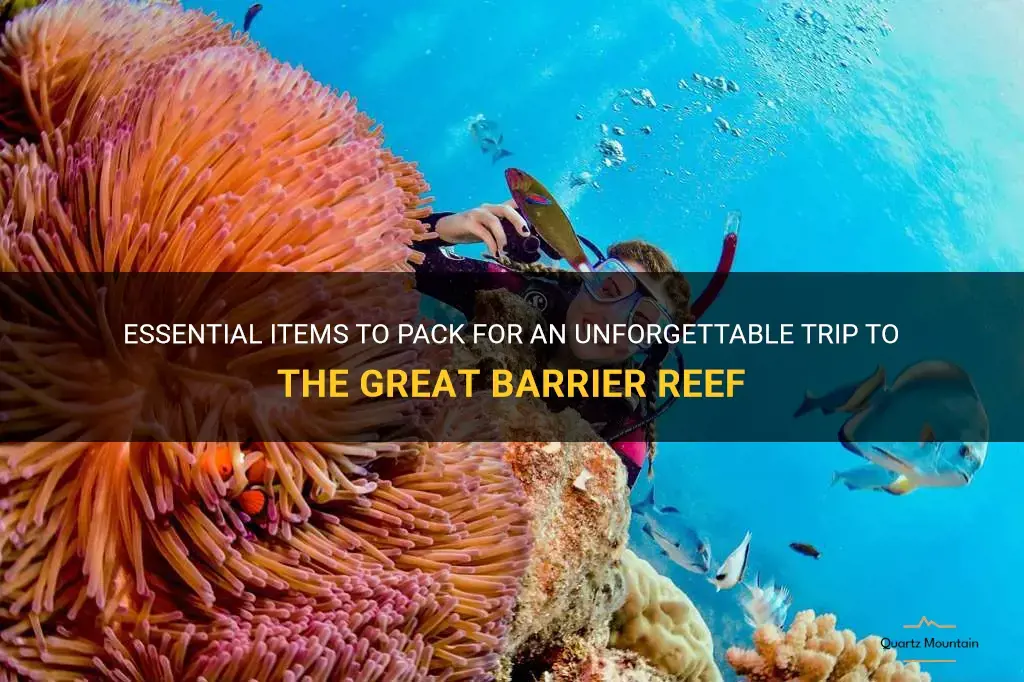
Embarking on a journey to the Great Barrier Reef is a dream come true for many nature enthusiasts. The world's largest coral reef system, spanning over 2,300 kilometers, offers a truly unforgettable experience. But before diving into the crystal-clear waters and exploring the vibrant marine life, it's crucial to pack the right essentials. From reef-safe sunscreen to underwater cameras, this guide will ensure you have everything you need to make your trip to the Great Barrier Reef truly unforgettable.
What You'll Learn
- What are the essential items to pack for a trip to the Great Barrier Reef?
- Are there any clothing or gear recommendations for snorkeling or diving in the Great Barrier Reef?
- Are there any specific safety precautions or equipment that should be included in a packing list for the Great Barrier Reef?
- Are there any specific medications or first aid supplies that should be included when packing for a trip to the Great Barrier Reef?
- Are there any environmental considerations to keep in mind when choosing what to pack for the Great Barrier Reef?

What are the essential items to pack for a trip to the Great Barrier Reef?
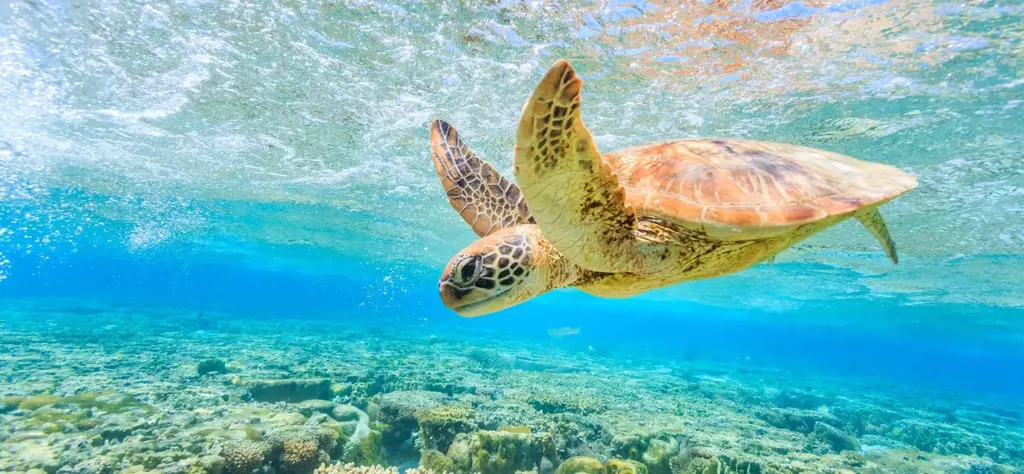
The Great Barrier Reef in Australia is one of the most breathtaking natural wonders in the world and a popular destination for travelers. If you're planning a trip to the Great Barrier Reef, it's important to pack the right essentials to ensure you have a comfortable and enjoyable experience. Here are some essential items to consider bringing with you:
- Snorkeling or diving gear: If you plan on exploring the stunning underwater world of the Great Barrier Reef, it's important to have your own snorkeling or diving gear. This includes a mask, snorkel, fins, and wetsuit (if needed). Having your own gear ensures a proper fit and reduces the risk of discomfort or leakage, allowing you to fully immerse yourself in the vibrant marine life.
- Sun protection: The Great Barrier Reef is bathed in abundant sunshine, which means it's essential to protect your skin from harmful UV rays. Be sure to pack a broad-spectrum sunscreen with a high SPF, a wide-brimmed hat, and a rash guard or long-sleeved shirt. These items will help shield you from the sun's rays and prevent sunburn.
- Reef-safe sunscreen: It's important to note that many conventional sunscreen products contain chemicals that can harm coral reefs and marine life. To protect the delicate ecosystem of the Great Barrier Reef, opt for reef-safe sunscreen that is free from oxybenzone and octinoxate. These ingredients have been shown to contribute to coral bleaching, so choosing a reef-safe alternative is a responsible choice.
- Sea sickness remedies: If you're prone to motion sickness, it's a good idea to pack some sea sickness remedies. This can include over-the-counter medications, seasickness patches, or natural remedies such as ginger candies or wristbands. Being prepared can help alleviate any discomfort and allow you to fully enjoy your time on the water.
- Waterproof bag or dry sack: When visiting the Great Barrier Reef, it's highly likely that you'll be spending a significant amount of time in or near the water. To protect your belongings, such as your phone, camera, or extra clothes, it's important to have a reliable waterproof bag or dry sack. This will keep your items safe from water damage and allow you to capture those stunning underwater moments.
- Sturdy water shoes: The Great Barrier Reef is home to a diverse ecosystem, including sharp coral, rocks, and other potentially hazardous surfaces. To protect your feet and prevent any injuries, it's advisable to wear sturdy water shoes. These will provide traction, support, and protection while navigating the reef or walking on the beach.
- Reusable water bottle: Staying hydrated is crucial, especially in the warm and tropical climate of the Great Barrier Reef. Instead of relying on single-use plastic bottles, bring a reusable water bottle that you can refill throughout the day. Help minimize plastic waste and contribute to the preservation of this natural wonder.
- Underwater camera: Don't miss the opportunity to capture the incredible beauty of the Great Barrier Reef. Consider investing in an underwater camera or a waterproof housing for your existing camera. This will allow you to take stunning photos and videos of the colorful marine life and create lasting memories.
Remember to pack these essentials for your trip to the Great Barrier Reef to ensure a comfortable and enjoyable experience. By being prepared and conscientious of the environment, you can fully immerse yourself in the wonders of this underwater paradise while preserving its beauty for future generations.
Essential Clothing to Pack for a Trip to Arenal, Costa Rica
You may want to see also

Are there any clothing or gear recommendations for snorkeling or diving in the Great Barrier Reef?
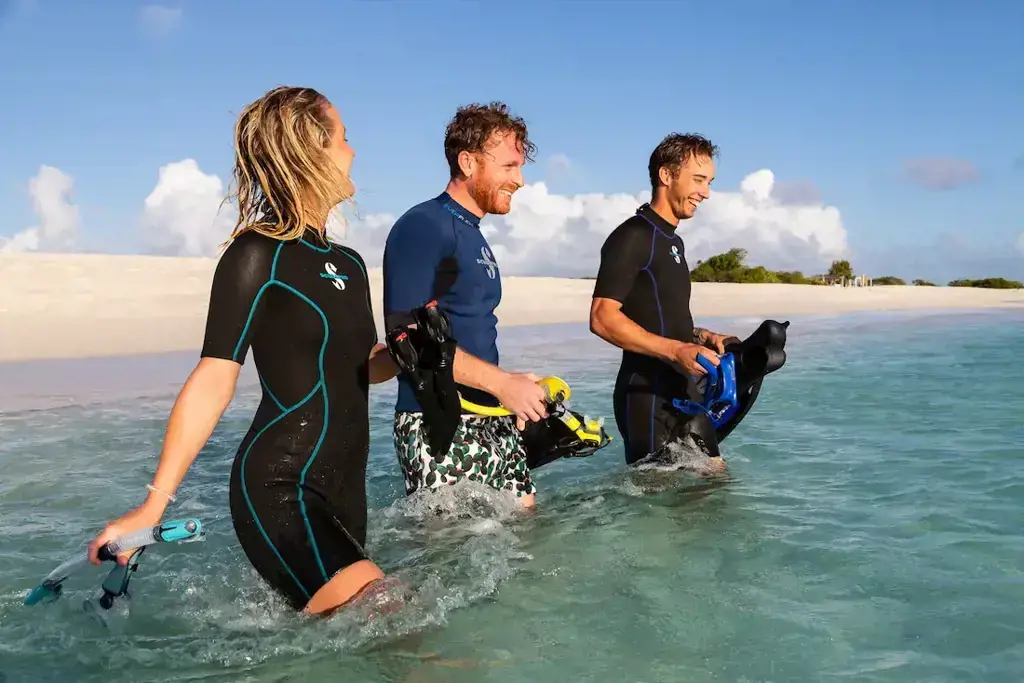
When planning a trip to the Great Barrier Reef for snorkeling or diving, it is essential to consider the right clothing and gear for such activities. The Great Barrier Reef, located off the coast of Queensland, Australia, is home to an incredible diversity of marine life and is one of the most popular destinations for underwater exploration. To ensure an enjoyable and safe experience, it is important to come prepared with the right equipment.
The first item to consider is a well-fitting wetsuit or rash guard. Even though the waters of the Great Barrier Reef are generally warm, a wetsuit or rash guard can provide protection against sunburn, jellyfish stings, and minor scrapes or cuts. It also helps to maintain body heat during extended periods of time in the water. A wetsuit with a thickness of 3mm is typically suitable for most diving and snorkeling activities in the region.
In addition to a wetsuit or rash guard, it is important to have a good quality snorkel and mask. A snorkel allows you to breathe while floating face down on the water's surface, providing an excellent way to observe the vibrant marine life of the reef without the need for diving gear. When choosing a snorkel, opt for a dry-top snorkel, which prevents water from entering the breathing tube even when submerged. A silicone mask with a comfortable fit and a wide field of vision is essential for clear underwater views.
For those planning to go scuba diving, a full set of dive gear is necessary. This includes a buoyancy control device (BCD), regulator, dive computer, and fins. The BCD allows you to control your buoyancy underwater, while the regulator supplies you with a consistent flow of air from the diving tank. A dive computer helps you monitor your depth, bottom time, and decompression limits, ensuring a safe and controlled dive. It is important to invest in high-quality gear and have it properly maintained and serviced regularly.
Another key consideration is sun protection. The Great Barrier Reef region is known for its intense sun, so it is important to apply a high SPF sunscreen regularly and wear a wide-brimmed hat and sunglasses to protect your face and eyes from harmful UV rays. Additionally, consider wearing a rash guard or wetsuit with built-in sun protection for added coverage.
It is worth mentioning that some dive operators in the Great Barrier Reef region provide equipment rentals as part of their diving packages. This can be a convenient option for those who do not want to invest in purchasing their own gear or do not have the means to transport it. However, it is important to ensure that the rental equipment is of high quality and properly maintained.
In summary, when planning a trip to snorkel or dive in the Great Barrier Reef, it is important to come prepared with the right clothing and gear. A wetsuit or rash guard, snorkel and mask, and full dive gear are all essential. Sun protection is also crucial, including sunscreen, a wide-brimmed hat, and sunglasses. Whether you choose to purchase your own gear or rent it from a dive operator, ensuring it is of high quality and properly maintained is key to having a safe and enjoyable experience exploring the wonders of the Great Barrier Reef.
Essential Items to Pack for a Memorable Vacation in Ireland
You may want to see also

Are there any specific safety precautions or equipment that should be included in a packing list for the Great Barrier Reef?
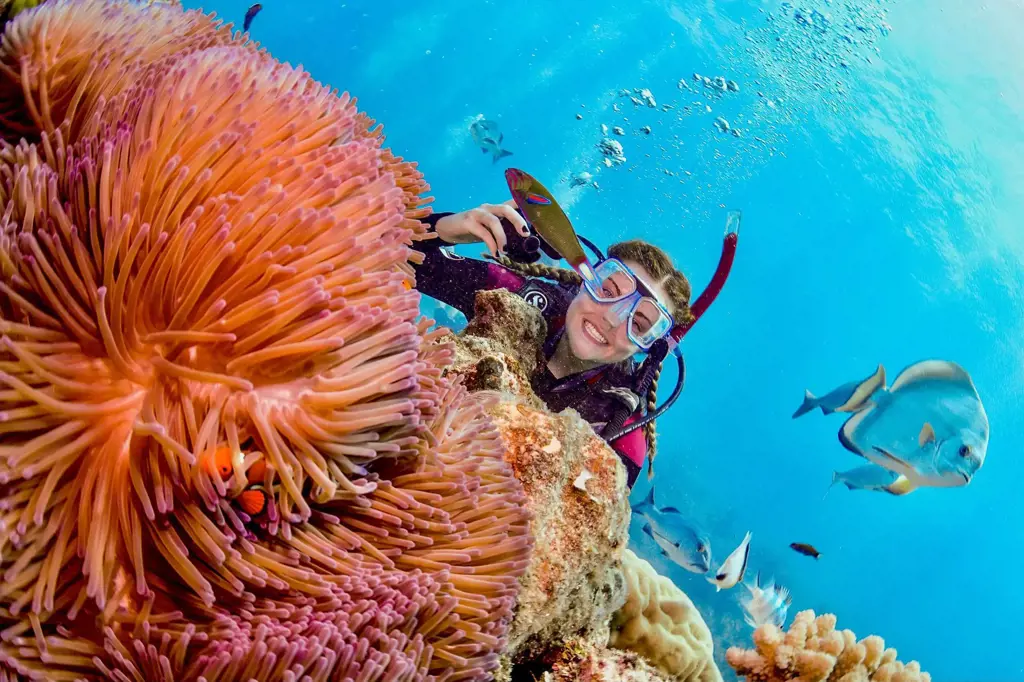
The Great Barrier Reef is one of the most popular tourist destinations in the world, attracting millions of visitors each year. While it is an incredible place to explore and enjoy, it is important to take certain safety precautions and pack the right equipment to ensure a safe and enjoyable trip.
First and foremost, it is crucial to protect yourself from the strong Australian sun. The sun can be intense, especially out on the water, so it is important to bring sunscreen with a high SPF rating. Additionally, it is recommended to wear a wide-brimmed hat and UV-protective clothing to shield your skin from the harmful rays. Sunglasses are also a must to protect your eyes from the bright sunlight and reflection off the water.
If you are planning on snorkeling or diving in the Great Barrier Reef, there are a few additional safety precautions and equipment that should be included in your packing list. It is recommended to bring your own snorkel and mask, as renting equipment can be expensive and may not fit properly. Having your own equipment will ensure a comfortable and secure fit, allowing you to fully enjoy your underwater experience.
For those planning to dive, proper certification is essential. The Great Barrier Reef has incredible dive sites, but they can also be challenging. It is important to have the necessary training and experience to dive safely. If you are not certified, you can take a diving course before your trip or opt for a guided snorkeling tour instead.
In terms of safety equipment, it is recommended to have a safety sausage or signaling device with you while diving. These devices can be easily inflated at the surface and act as a visual signal to alert nearby boats of your location. A dive knife or cutting tool is also advisable for any potential emergency situations, such as entanglement in underwater vegetation or fishing lines.
When exploring the Great Barrier Reef, it is important to respect the fragile ecosystem and follow the guidelines set by the marine park authorities. This includes not touching or standing on the coral, avoiding dropping anchor in sensitive areas, and not feeding or chasing marine life. By being a responsible visitor, you can help preserve the beauty and biodiversity of the reef for future generations to enjoy.
In conclusion, when packing for a trip to the Great Barrier Reef, specific safety precautions and equipment should be kept in mind. Protecting yourself from the sun with sunscreen, hats, and sunglasses is essential. If snorkeling or diving, bringing your own equipment and being certified are important for a safe and enjoyable experience. Safety equipment such as signaling devices and dive knives should also be considered. Lastly, it is crucial to be a responsible visitor and follow the guidelines set by the marine park authorities to protect the reef's fragile ecosystem. By taking these precautions and having the right equipment, you can have an unforgettable and safe experience exploring the Great Barrier Reef.
Which Backpack Should You Bring to Bonnaroo?
You may want to see also

Are there any specific medications or first aid supplies that should be included when packing for a trip to the Great Barrier Reef?
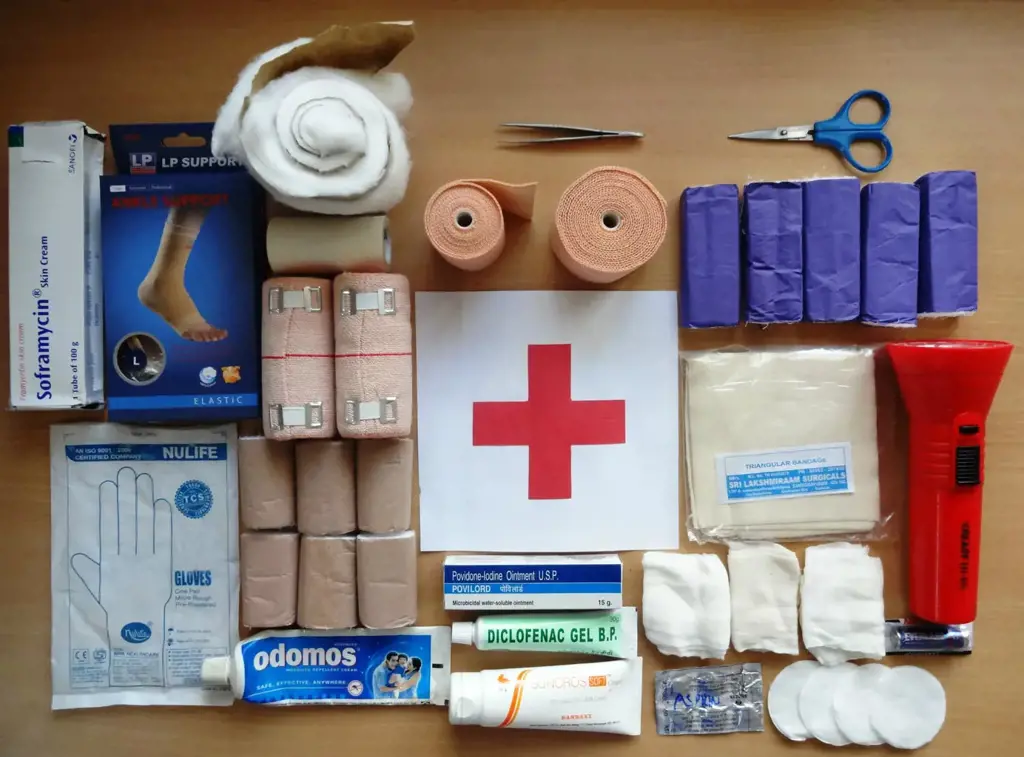
When preparing for a trip to the Great Barrier Reef, it is important to be prepared for any potential medical emergencies or minor injuries that may occur. While the Reef is a beautiful and safe destination, there are certain medications and first aid supplies that you should include in your packing list to ensure your safety and well-being. Below are some recommendations:
- Sunscreen: The Great Barrier Reef is located in Australia, where the sun can be extremely intense. It is important to pack a high SPF sunscreen to protect your skin from harmful UV rays. Look for a broad-spectrum sunscreen that protects against both UVA and UVB rays.
- Motion sickness medication: If you are prone to motion sickness, consider packing over-the-counter motion sickness medication. This can be particularly helpful if you are planning to go on boat trips or snorkeling excursions, as the water can sometimes be rough.
- Antihistamines: The Reef is home to various marine life, including coral and jellyfish. While encounters with dangerous marine life are rare, it is advisable to pack antihistamines in case of allergic reactions to jellyfish stings or other marine organisms.
- Hydrocortisone cream: In the event of minor skin irritations, such as rashes or insect bites, hydrocortisone cream can provide relief. It can help reduce itching and inflammation caused by these irritants.
- Antibacterial ointment: It is always a good idea to have some antibacterial ointment on hand in case of cuts or abrasions. This can help prevent infection and aid in the healing process.
- Bandages and adhesive tape: Minor cuts and blisters can happen while exploring the Reef. Packing a variety of bandages and adhesive tape can help cover and protect these wounds until further medical attention can be received.
- Tweezers: Tweezers can be useful for removing splinters or other foreign objects from the skin. They can also be handy for removing ticks if you plan on venturing into any nearby forests or parks.
- Pain relievers: Headaches or mild body aches can sometimes occur during long days of exploration. Packing over-the-counter pain relievers, such as ibuprofen or acetaminophen, can help alleviate these discomforts.
Remember to check with your healthcare provider before taking any medications, especially if you have any underlying medical conditions or are currently taking prescription medications. It is also a good idea to familiarize yourself with proper first aid techniques and emergency protocols before embarking on your trip.
In conclusion, packing a well-stocked first aid kit with the necessary medications and supplies is essential for a safe and enjoyable trip to the Great Barrier Reef. By being prepared, you can quickly address any minor injuries or medical issues that may arise, allowing you to fully enjoy all that this stunning natural wonder has to offer.
Essential Items to Pack for a Fall Trip to Germany
You may want to see also

Are there any environmental considerations to keep in mind when choosing what to pack for the Great Barrier Reef?
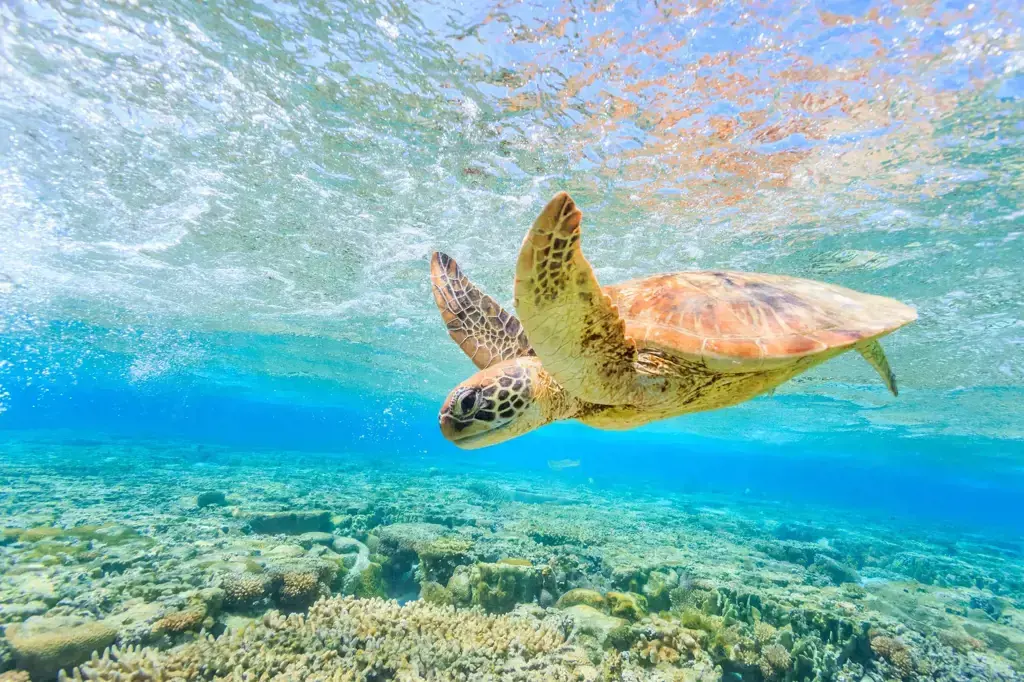
When planning a trip to the Great Barrier Reef, it is important to consider the environmental impacts of your choice in packing. The Great Barrier Reef is one of the most diverse ecosystems in the world, and it is vital that we take steps to protect and preserve this natural wonder. Here are a few environmental considerations to keep in mind when choosing what to pack for your trip to the Great Barrier Reef:
- Sunscreen: While sunscreen is crucial for protecting your skin from harmful UV rays, certain ingredients in sunscreen can harm coral reefs. Chemicals like oxybenzone and octinoxate have been found to bleach and damage coral, even in small concentrations. When choosing a sunscreen for your trip, opt for a reef-safe sunscreen that does not contain these harmful chemicals. Look for sunscreens that are mineral-based, with ingredients like zinc oxide or titanium dioxide.
- Reef-friendly insect repellent: Mosquitoes and other insects can be a nuisance while visiting the Great Barrier Reef. However, many traditional insect repellents contain harmful chemicals that can harm marine life. Choose an insect repellent that is labeled as reef-friendly, or consider using natural alternatives like citronella or lemon eucalyptus oil.
- Biodegradable toiletries: It is important to choose biodegradable toiletries, including shampoos, soaps, and toothpaste, to minimize the impact on the fragile reef ecosystem. Traditional personal care products can contain chemicals that can be harmful to marine life when they enter the water. Look for products that are labeled as biodegradable, as they break down more easily and are less likely to harm the coral reef.
- Reusable water bottle: Plastic pollution poses a significant threat to the Great Barrier Reef, so it is essential to reduce your use of single-use plastics. Bring a reusable water bottle with you and consider investing in a portable water filter to ensure you always have access to clean drinking water. This simple step can significantly reduce the amount of plastic waste generated during your trip.
- Snorkeling gear: Snorkeling is one of the main attractions of the Great Barrier Reef, but it is essential to choose reef-friendly snorkeling gear. Avoid using equipment made from non-biodegradable materials like PVC or neoprene. Look for snorkeling gear made from natural rubber or silicone, as these materials are more environmentally friendly and less likely to harm the delicate coral reef.
By keeping these environmental considerations in mind when choosing what to pack for your trip to the Great Barrier Reef, you can minimize your impact on this incredible ecosystem. Remember, every small action counts when it comes to protecting and preserving the natural beauty of the Great Barrier Reef for future generations to enjoy.
The Ultimate Packing Guide: What to Pack in Your Backpack for a 6-Week Trip
You may want to see also
Frequently asked questions
When packing for a trip to the Great Barrier Reef, it is important to bring essentials such as sunscreen, a hat, and sunglasses to protect yourself from the sun. Additionally, you will want to bring swimwear and a rash guard for snorkeling or diving activities. Don't forget to pack a waterproof camera or underwater housing if you want to capture the amazing marine life you will encounter.
While some tour operators may provide snorkeling gear, it is generally a good idea to bring your own if you have it. This way, you can ensure a proper fit and be more comfortable in the water. If you don't have your own gear, you can rent it from various dive shops and tour operators near the Great Barrier Reef.
The need for a wetsuit will depend on the time of year you visit the Great Barrier Reef and your personal preference. During the warmer months (November to April), a wetsuit is not usually necessary. However, if you are visiting during the colder months (May to October), a wetsuit can provide some extra warmth, especially for extended water activities.
When exploring the Great Barrier Reef, it is recommended to wear reef-safe, non-slip footwear such as reef shoes or sandals. These will protect your feet from any sharp coral or rocks while still allowing you to easily walk on the reefs and in the shallow waters. It is important to choose footwear that does not have any protruding straps or hooks that could damage the delicate ecosystem of the reef.







